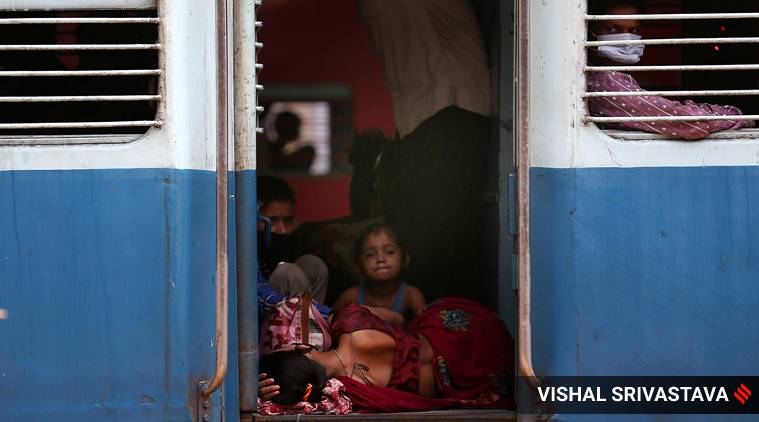 It was only in early May, nearly two months after the lockdown, when the economy started opening up, that the Shramik trains started running. Where and how did those who travelled in these spend the last two months? (Express Photo by Vishal Srivastava)
It was only in early May, nearly two months after the lockdown, when the economy started opening up, that the Shramik trains started running. Where and how did those who travelled in these spend the last two months? (Express Photo by Vishal Srivastava)
My 13-year-old son and eight-year-old daughter were as eager to get back from New York city as much as they had looked forward to being there. The story of my homecoming sounds quite crass when I read the stories of migrant workers waiting to return home. It took the intervention of the Karnataka High Court to order the government to pay for the travel of the migrants who had no work, no pay and no money to get back to their dear ones. It did not matter to many in high places that they were dying of exhaustion on their walk back home, or being run over on railway tracks and highways.
As I write this from an institutional five-star quarantine facility in Hyderabad, our biggest revolution is against the hotel management and with the government orders —asking for some fresh air to be let into our air-conditioned rooms. Coronavirus has made this much clear: We have one set of people fighting to be out in Hyderabad’s summer air, and there is another set, numerically much larger, whose only possession perhaps is the will to walk hundreds of miles in the hot sun towards their homes.
Most people quarantined in our hotel are aged/middle-aged, upper-caste parents returning from the US, the land where the migrants’ dreams come true. I may not have their caste and moneyed capital, but they do not have my cultural capital. Yes, I know their caste. Many make it a point to tell their second names, indicating their caste. I also had people asking me if I was vegetarian, or well, Brahmin. These parents whom I interact with are not fluent in English, they are scared of conversing with the management or the doctor or the police stationed 24/7 at the hotel. Some rely on me (and my children) to navigate technology, fill forms in English, and to talk to whichever authority. But yet, they were able to meet the exorbitant cost of the ticket from the US to India, choose the “premium category” of quarantine, and even bicker about the food served to us. As we wait to receive the food served outside the room in the hotel corridor, conversations range from how many children each has in the US to what is served in the other hotels where their acquaintances are quarantined, and how suffocating it can get inside AC rooms. We even ventured to ask for biryani on Eid.
Do I need to contrast these US-migrant dreams with dreams of migrants’ stories of homecoming within India? The protagonist of the Indian-American dream is not a migrant-worker. Theirs is largely a story of choice. This cannot be the story of the worker-migrant, more often than not belonging to the so-called lower castes and to Adivasi communities, displaced from their homelands multiple times for various reasons, the most popular reason being that of the “greater common good”, without choice or voice.
I was anxious about returning from New York, where I had gone on a fellowship. I kept writing to everyone I could, from the ambassador of India in the US to friends, about repatriation flights. The Indian embassy always replied. Was this kind of efficiency available to the migrant-worker? What about the blue-collar Indian workers in the Gulf? I know that in Jordan and Singapore, workers from India are struggling in dormitories. It was only in early May, nearly two months after the lockdown, when the economy started opening up, that the Shramik trains started running. Where and how did those who travelled in these spend the last two months? That they had to wait in the scorching sun with luggage on their head for buses to take them to the railway station, that they were hosed down with chemical disinfectants while booking their tickets, that they waded through the Yamuna in the hope of reaching home, that there was no water and many times the packets of food given to them were stale, that their dismembered bodies lay on the rail tracks, while some of us fought to be let out for some fresh air says a lot about the society we are.
This article first appeared in the print edition on May 26, 2020 under the title ‘Migration: Ours And Theirs’.
The writer teaches at the University of Hyderabad